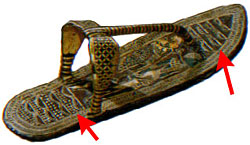
Bow
(iunet, pedjat)
Appearance: Iconoclastically, the bow was typically shown horizontally with the bow string bound to the mid-section of the bow staff to avoid its warping under the string's constant pull when not in use. The bow was the most powerful and effective weapon in the ancient world.
Meaning: From early times the bow was a symbol and attribute of the warrior goddess Neith and she was often portrayed holding the weapon.
The bow could also represent whole nations. The enemies of Egypt were frequently referred to as "The Nine Bows". They were sometimes depicted as actual bows or personified as ethnically differentiated captives. On Tutankhamen's sandals, the hieroglyphic sign of the bow is repeated on the soles, thereby allowing the king to symbolically step on and subjugate his enemies.
The bow was also depicted held by various gods or kings who hold the weapon backwards with the string turned toward captives in a gesture of dominance. In some scenes surrendering enemies are shown holding their bows over their heads in this manner, perhaps symbolically beneath the dominance of the victorious Egyptian Pharaoh.
Digg This!
![]() Del.icio.us
Del.icio.us
![]() Stumble Upon
Stumble Upon
